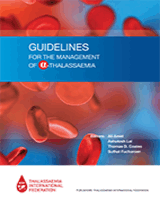From: Chapter 12, CURATIVE THERAPIES FOR α-THALASSAEMIA

NCBI Bookshelf. A service of the National Library of Medicine, National Institutes of Health.
In 1998, the first transplant in severe α-thalassaemia was conducted in a 21-month-old girl from a matched sibling donor after conditioning with busulfan (Bu) and cyclophosphamide (Cy). Transfusion independence was achieved post-transplant despite residual recipient haematopoietic stem cells (HSCs) [46]. Since then, just a few case reports describing successful transplant in α-thalassaemia have been published, in contrast to thousands of transplants conducted for β-thalassaemia. This observation highlights the significance and particular challenges we are encountering as we work to create a curative therapy option for patients with α-thalassaemia.
From: Chapter 12, CURATIVE THERAPIES FOR α-THALASSAEMIA

NCBI Bookshelf. A service of the National Library of Medicine, National Institutes of Health.